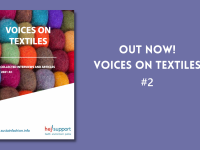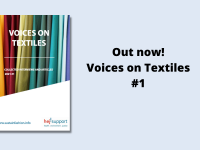Human Rights Violations in the Garment Sector: Women Are Most at Risk

Gender Equity in Textile Production
In the past several decades, the garment industry has been in the international spotlight as the result of the frequent perpetuation of poor working conditions and human rights violations throughout the sector. While some corporations have taken steps to address these issues, many problems remain unaddressed and unresolved.
In recent news in 2020, factory fires in the garment industry were reported across 18 countries, leading to 50 injuries and 4 deaths.1
According to the organization HERproject, women make up approximately 70% of the garment workforce and 45% of the textile sector workforce, a particular subsector of the garment workforce which primarily produces clothing fibers.2 In addition to the general human rights matters attributable to the textile and garment industry, there are also gender-specific issues that need to be highlighted and addressed. For example, it has been reported that nearly 70% of women employed in footwear factories in Vietnam have gynecological infections, potentially stemming from the poor hygienic conditions of their working environments.3 Despite numerous instances of rape and sexual assault of garment workers, a report released by Karmojibi Nari and the International Women’s Rights Action Watch Asia Pacific found that less than 70% of factories in Bangladesh had anti-harassment committees.4 The issues facing textile factory workers, in particular female factory workers, have been extensively researched and discussed. Unfortunately, recent world events such as the current pandemic have further exacerbated these issues, leading to increased disenfranchisement of those vulnerably employed in the industry.
Textile Production During the COVID-19 Pandemic
A survey of thousands of buyers and suppliers across more than 100 countries has found that garment and footwear sectors are among the industries which have been most impacted economically by the COVID-19 pandemic.5 The vulnerability of the textile sector to financial losses is due in part to its reliance on global supply chains and consistent performance by fashion corporations in developed countries.6 As retail storefronts have closed and consumer demand has declined, global brands have begun to cancel orders, request discounts, delay shipments, and violate their contracts with their suppliers.7 By early April 2020, Inditex, the parent company of popular brand Zara, had already written off about $336 million worth of inventory.8
Vijay Mahtaney, chairman of Ambattur Fashion India, who along with his partners employs nearly 20,000 workers across India, Jordan, and Bangladesh, claims that corporations supplied by the garment factories have begun to request discounts for outstanding payments, even going so far as to issue cancellations for orders already in production.9 One American retailer apparently requested a 30% discount for all items, including those which had already been delivered.9 Multinational corporations that are experiencing financial strain under the pandemic are perpetuating these struggles throughout the supply chain, affecting livelihoods of workers involved in production facilities.
In addition to this, hundreds of thousands of people have lost their jobs, as factories shut down due to the global pandemic crisis.5 These economic ripples are causing high levels of additional distress among textile workers across the world.
In Bangladesh, 80% of the economy is dependent on the garment sector.10 Labor rights activist Kalpona Akter claims that in the month of March 2020, more than 50% of these workers were not paid their wages in full.10
In Jakarta, Indonesia, over 30,000 workers had been laid off by April 2020.6
Similarly in Vietnam,the textile manufacturer Vinatex, which controls close to 10% of the market share in the country and services clientele including such brands as H&M and Zara, claimed in April 2020 that about 50,000 of their workers had the potential to be laid off due to a lack of orders.11 In total, Oxfam Canada estimates that the implications of workplace closures and job losses could cause an additional 8% of the global population to enter into poverty.10
In addition to many workers losing their jobs and sources of income, those that remain employed and working are put at risk of contracting the COVID-19 virus. In Cambodia, 40% of the country’s gross domestic product is attributable to the garment industry, which employs approximately 850,000 people nationally; the reliance of the economy on the garment industry was used to justify keeping factories open, while their counterparts in neighboring countries were forced to shut down.12 Although factories remained open, worker suspensions continued to occur, with those being laid off receiving only over a third of their salary through joint assistance provided by the government and their employers.12 Those who remain working undoubtedly struggle to maintain physical distancing measures to keep in line with pandemic protocol.
One of the most significant COVID-19 outbreaks in Guatemala has been traced back to a garment factory in Guatemala City, where over 200 of the K.P. Textil company’s 900 staff contracted the SARS-CoV-2 virus.13
Implications for Women
An analysis by the Institute for Fiscal Studies revealed that women were more likely to work in a sector impacted by shutdowns resulting from the pandemic, with higher likelihood of negatively impacted earnings.14 Due to issues such as these, experts say the pandemic may exacerbate gender inequalities.15
Of all the textile, clothing and footwear industry workers in Indonesia, 58% are women.6 In Bangladesh, approximately half of all employed women find themselves in the textile or garment industry, many of whom are now living off of reduced income or losing their jobs altogether.15
Patriarchal notions throughout the world impose ideas on women’s capabilities and worth, such that their work is often associated with unskilled labor and considered expendable; this consequentially leads to the undervaluing and undercompensating of their working abilities and unjust discrimination towards them as individuals.6 Women are impacted most by production losses because they account for the majority of workers that do not hold permanent statuses, increasing their vulnerability to economic injustice and layoffs.6 For these reasons and others, women tend to be laid off earlier than their male coworkers.6
Globally, societal norms often dictate that women should be responsible for most of the household and family care duties.15 In the midst of the pandemic, when other supports are not as widely available, many women have even more demands to take on, which may influence them to leave their jobs in order to provide family support at home and thus adversely affecting their financial situation.15
Solutions
The issues emerging during the pandemic that disenfranchise workers, particularly women, are not new but are caused by systemic issues that have persisted for decades in the textile industry.10 Therefore, in order for these issues to be mitigated, their root causes must be further examined and addressed.
Initially, it is important that multinational corporations commit to supporting the factories and workers that supply their products. For example, public pressure has motivated corporations like Inditex and H&M to pay their suppliers in full for existing orders.9 A plan initiated by a variety of global stakeholders advocating for labor rights, such as the International Trade Union Confederation and the International Labor Organisation, has now been endorsed by a variety of prominent international retailers, including H&M, Adidas, Under Armour and Primark.16 This plan involves providing financial assistance to at-risk garment factories and associated workers that have been impacted by the economic consequences of the pandemic.16 Optimists believe that from this experience, the possibility may arise to strengthen workers’ rights in the future, securing important basic needs such as healthcare benefits and employment protection.16
Beyond pandemic funding and measures, companies can care for their female textile and garment workers in particular by fostering safe and inclusive spaces for them within the workplace. HERproject works to alleviate gender inequalities through tailored workplace-based interventions in garment factories of such notable fashion brands as Nordstrom, Levi’s and Ralph Lauren.17 The programs operated by HERProject include initiatives which educate women on their health, provide and teach financial literacy, and work to address gender-based violence.18 After twelve years of involvement in the HERproject, Nordstrom has taken the bold step of committing to produce 70% of its own brand apparel in factories that ‘support women’s empowerment’ by the year 2023.18
In June of 2020, the UN Working Group on Business and Human Rights, in partnership with other stakeholders, will host a series of discussions on how to proceed in advocating for business and workers’ rights beyond the current pandemic, including ‘tackling gender bias in recovery plans’ and fostering sustainable practices.19
Moving forward, in order to strengthen the rights of textile and garment factory employees around the world, there must be a focus on supporting the rights and livelihoods of individual workers, as opposed to bailing out the multinational corporations who foster the conditions for their oppression.10
References
- Glover, S. (2020, April 7). Factory fire report paints grim safety picture. Ecotextile News. Retrieved from: https://www.ecotextile.com/2020040725930/social-compliance-csr-news/factory-fire-report-paints-grim-safety-picture.html
- BSR HERproject. (n.d.). What we do. Retrieved from: https://herproject.org/about/what-we-do
- Preet, R. (2019, October 31). Vietnam records high female employment but challenges remain. Vietnam Briefing. Retrieved from: https://www.vietnam-briefing.com/news/vietnam-records-high-female-employment-challenges-remain.html/
- Remington, C. (2020, February 10). Bangladeshi workers call for anti-harassment committees. Ecotextile News. Retrieved from: https://www.ecotextile.com/2020021025672/social-compliance-csr-news/bangladeshi-workers-call-for-anti-harassment-committees.html
- Glover, S. (2020, June 2). Apparel sector ‘hardest hit by pandemic’. Ecotextile News. Retrieved from: https://www.ecotextile.com/2020060226145/materials-production-news/apparel-sector-hardest-hit-by-pandemic.html
- Misbahul Pratiwi, A. (2020, April 21). Women manufacturing workers hit hardest. The Jakarta Post. Retrieved from: https://www.thejakartapost.com/academia/2020/04/21/women-manufacturing-workers-hit-hardest.html
- Remington, C. (2020, April 23). European Commission handed ‘shadow strategy’. Ecotextile News. Retrieved from: https://www.ecotextile.com/2020042326001/materials-production-news/european-commission-presented-with-shadow-strategy.html
- Radharaman, K. (2020, April 3). If the textile industry is to recover from the lockdown, it needs quick government help. The Wire. Retrieved from: https://thewire.in/business/textile-industry-covid-19-government-help
- Oi, M., & Hoskins, P. (2020, April 10). Clothing makers in Asia give stark coronavirus warning. BBC News. Retrieved from: https://www.bbc.com/news/business-52146507
- Stefov, D. (2020, April 24). Economy & COVID-19: Twin train wrecks for the women who make our clothes. Oxfam Canada. Retrieved from: https://www.oxfam.ca/blog/the-twin-train-wrecks-of-the-economy-and-the-coronavirus-reflections-from-the-women-that-make-our-clothes/?gclid=Cj0KCQjww_f2BRC-ARIsAP3zarF_qyqS8HaeVEq8PtvqYZvdE4KeiQUp532xHpV1uyVx58EiPbhuBSEaAuTSEALw_wcB
- Glover, S. (2020, April 21). Textile giant could lay off 50,000 workers. Ecotextile News. Retrieved from: https://www.ecotextile.com/2020042125984/materials-production-news/textile-giant-could-lay-off-50-000-workers.html
- Thomas Reuters Foundation. (2020, April 14). ‘Please, we are not animals’: Virus fears weigh on Cambodia’s garment workers. Eco-Business. Retrieved from: https://www.eco-business.com/news/please-we-are-not-animals-virus-fears-weigh-on-cambodias-garment-workers/
- Remington, C. (2020, May 29). Factory in Guatemala ravaged by virus outbreak. Ecotextile News. Retrieved from: https://www.ecotextile.com/2020052926137/materials-production-news/factory-in-guatemala-ravaged-by-virus-outbreak.html
- Joyce, R., & Xu, X. (2020, April 6). Sector shutdowns during the coronavirus crisis: Which workers are most exposed? Institute for Fiscal Studies. Retrieved from: https://www.ifs.org.uk/publications/14791
- Grown, C. & Sanchez-Paramo, C. (2020, April 20). The coronavirus is not gender-blind, nor should we be. World Bank Blogs. Retrieved from: https://blogs.worldbank.org/voices/coronavirus-not-gender-blind-nor-should-we-be
- Glover, S. (2020, April 22). Reaction to cross-industry COVID-19 plan. Ecotextile News. Retrieved from: https://www.ecotextile.com/2020042225998/fashion-retail-news/reaction-to-cross-industry-covid-19-plan.html
- Remington, C. (2020, February 18). Bestseller strengthens engagement with workers’ rights NGO. Ecotextile News. Retrieved from: https://www.ecotextile.com/2020021825709/fashion-retail-news/bestseller-strengthens-engagement-with-workers-rights-ngo.html
- Styles, D. (2019, June 21). Nordstrom aims to empower women in fashion. Ecotextile News. Retrieved from: https://www.ecotextile.com/2019062124431/social-compliance-csr-news/nordstrom-aims-to-empower-women-in-fashion.html
- Remington, C. (2020, June 5). UN to host forum on business and worker rights. Ecotextile News. Retrieved from: https://www.ecotextile.com/2020060526166/social-compliance-csr-news/un-to-host-forum-on-business-and-worker-rights.html






